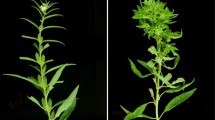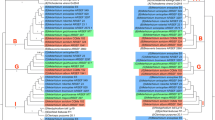Abstract
In continuing previous work on the role of AAA+ proteins of the apple proliferation agent ‘Candidatus Phytoplasma mali’ in phytoplasma virulence and suppression of virulence, 147 full-length deduced protein sequences of AAA+ ATPase AP460 of single- and multiple-strain accessions were examined. This approach revealed that in this protein two regions can be distinguished. Region 1, located in the N-terminal part, is characterized by 14 highly conserved substitutions associated with the suppression of virulence. However, these substitutions were not present in all attenuated strains. In the more diverse region 2, located in the C-terminal part, highly conserved substitutions associated with two groups of virulence were identified. In addition to the virulence-related residues, three other groups of conserved substitutions are present in strains with attenuated virulence with or without the presence of suppression-associated substitutions in region 1. In one of these groups, substitutions next to key residues of the ATPase motifs sensor 1 and 2 and arginine finger do occur that seem to affect ATPase function. This group of substitution was present in all attenuated strains. From these findings it can be concluded that two different mechanisms of suppression exist of which the supposed effect on ATPase function seems to be more important than the suppression-associated substitutions in region 1. The presence of virulent, avirulent and suppressive strains in a tree leads in the commonly occurring multiple infections to interactions in which the resulting virulence is determined by the numerical relation of virulent and attenuated strains.



Similar content being viewed by others
References
Carraro, L., Ermacora, P., Loi, N., & Osler, R. (2004). The recovery phenomenon in apple proliferation-infected apple trees. Journal of Plant Pathology, 86, 141–146.
Caudwell, A. (1961). Les phénomènes de rétablissment chez la flavescence dorée de la vigne. Annales des Epiphyties, 12, 347–354.
Chang, J. H., Desveaux, D., & Creason, A. L. (2014). The ABCs and 123s of bacterial secretion systems in plant pathogenesis. Annual Review of Phytopathology, 52, 317–345.
Costa, T. R. D., Felisberto-Rodrigues, C., Meir, A., Prevost, M. S., Redzej, A., Trokter, M., & Waksman, G. (2015). Secretion systems in gram-negative bacteria: Structural and mechanistic insights. Nature Reviews Microbiology, 13, 343–359.
DiGiuseppe Champion, P. A., Champion, M. M., Manzanillo, P., & Cox, J. S. (2009). ESX-1 secreted virulence factors are recognized by multiple cytosolic AAA ATPases in pathogenic mycobacteria. Molecular Microbiology, 73, 950–962.
Frees, D., Sorensen, K., & Ingmer, H. (2005). Global virulence regulation in Staphylococcus aureus: Pinpointing the roles of ClpP and ClpX in the sar/agr regulatory network. Infection and Immunity, 73, 8100–8108.
Hanson, P. I., & Whiteheart, S. W. (2005). AAA+ proteins: Have engine, will work. Nature Reviews Molecular Cell Biology, 6, 519–529.
Himmelreich, R., Hilbert, H., Plagens, H., Pirkl, E., Li, B. C., & Herrmann, R. (1996). Complete sequence analysis of the genome of the bacterium Mycoplasma pneumoniae. Nucleic Acids Research, 24, 4420–4449.
Hoshi, A., Oshima, K., Kakizawa, S., Ishii, Y., Ozeki, J., Hashimoto, M., Komatsu, K., Kakiwanda, S., Jamaji, Y., & Namba, S. (2009). A unique virulence factor for proliferation and dwarfism in plants identified from a phytopathogenic bacterium. Proceedings of the National Academy of Sciences USA, 106, 6416–6421.
Janik, K., Mithöfer, A., Raffeiner, M., Stellmach, H., Hause, B., & Schlink, K. (2016). An effector of apple proliferation phytoplasma targets TCP transcription factors - a generalized virulence strategy of phytoplasma? Molecular Plant Patholology. doi:10.1111/mpp.12409.
Jarocki, V. M., Santos, J., Tacchi, J. L., Raymond, B. B. A., Deutscher, A. T., Jenkins, C., Padula, M. P., & Djordjevic, S. P. (2015a). MHJ_0461 is a multifunctional leucine aminopeptidase on the surface of Mycoplasma hyopneumoniae. Open Biology, 5, 140175.
Jarocki, V. M., Tacchi, J. L., & Djordjevic, S. P. (2015b). Non-proteolytic functions of microbial proteases increase pathological complexity. Proteomics, 15, 1075–1088.
Joshi, S. A., Ball, D. A., Sun, M. G., Carlsson, F., Watkins, B. Y., Aggarwal, N., McCracken, J. M., Huynh, K. K., & Brown, E. J. (2012). EccA1, a component of the Mycobacterium marinum ESX-1 protein virulence factor secretion pathway, regulates mycolic acid lipid synthesis. Chemical Biology, 19, 372–380.
Käll, L., Krogh, A., & Sonnhammer, E. L. L. (2004). A combined transmembrane topology and signal peptide prediction method. Journal of Molecular Biololgy, 338, 1027–1036.
Käll, L., Krogh, A., & Sonnhammer, E. L. L. (2005). An HMM posterior decoder for sequence feature prediction that includes homology information. Bioinformatics, 21, 1251–1257.
Kannan, T. R., Provenzano, D., Wright, J. R., & Baseman, J. B. (2005). Identification and characterization of human surfactant protein a binding protein of Mycoplasma pneumoniae. Infection and Immunity, 3, 2828–2834.
Kannan, T. R., Musatovova, O., Gowda, P., & Baseman, J. B. (2008). Characterization of a unique ClpB protein of Mycoplasma pneumoniae and its impact on growth. Infection and Immunity, 76, 5082–5092.
Karata, K., Inagawa, T., Wilkinson, A. J., Tatsuta, T., & Ogura, T. (1999). Dissecting the role of a conserved motif (the second region of homology) in the AAA family of ATPases. Journal of Biological Chemistry, 274, 26225–26232.
Karata, K., Verma, C. S., Wilkinson, A. J., & Ogura, T. (2001). Probing the mechanism of ATP hydrolysis and substrate translocation in the AAA protease FtsH by modeling and mutagenesis. Molecular Microbiology, 39, 890–903.
Kube, M., Schneider, B., Kuhl, H., Dandekar, T., Heitmann, K., Migdoll, A. M., Reinhardt, R., & Seemüller, E. (2008). The linear chromosome of the plant-pathogenic mycoplasma 'Candidatus Phytoplasma mali'. BMC Genomics, 9, 306.
Langklotz, S., Baumann, U., & Narberhaus, F. (2012). Structure and function of the bacterial AAA protease FtsH. Biochimica et Biophysica Acta, 1823, 40–48.
Lithgow, J. K., Ingham, E., & Foster, S. J. (2004). Role of the hprT-ftsH locus in Staphylococcus aureus. Microbiology, 150, 373–381.
Luong, T. T., Sau, K., Roux, C., Sau, S., Dunman, P. M., & Lee, C. Y. (2011). Staphylococcus aureus ClpC divergently regulates capsule via sae and codY in strain Newman but activates capsule via codY in strain UAMS-1 and in strain Newman with repaired saeS. Journal of Bacteriology, 193, 686–694.
Luthra, A., Gaur, A., & Ramachandran, R. (2013). Rv3868 (EccA1), an essential component of the Mycobacterium tuberculosis ESX-1 secretion system, is thermostable. Biochimica et Biophysica Acta, 1834, 1181–1186.
Maclean, A. M., Sugio, A., Makarova, O. V., Findlay, K. C., Grieve, V. M., Toth, R., Nicolaisen, M., & Hogenhout, S. A. (2011). Phytoplasma effector SAP54 induces indeterminate leaf-like flower development in Arabidopsis plants. Plant Physiology, 157, 831–841.
Maixner, M., Kröhner, D., & Kappel, Y. (2011). Symptom remission and recovery in ´bois noir` infected grapevines. Bulletin of Insectology, 64(Suppl), S175–S176.
Morvan, G., Castelain, C., & Arnoux, M. (1986). Prospective for the control of apricot chlorotic leaf role, a mycoplasma disease, by cross protection. Acta Horticulturae, 192, 167–174.
Morvan, G., Castelain, C., Castellière, M.-G., & Audergon, J. M. (1991). An account of the attempts at controlling apricot chlorotic leaf role with cross protection. Acta Horticulturae, 193, 555–561.
Ogura, T., Whiteheart, S. T., & Wilkinson, A. J. (2004). Conserved arginine residues implicated in ATP hydrolysis, nucleotide sensing and inter-subunit interactions in AAA and AAA+ ATPases. Journal of Structural Biology, 146, 106–112.
Osler, R., Borselli, S., Ermacora, P., Loschi, A., Martini, M., Musetti, R., & Loi, N. (2014). Aquired tolerance in apricot plants that stably recovered from European stone fruit yellows. Plant Disease, 98, 492–496.
Pietrosiuk, A., Lenherr, E. D., Falk, S., Bönemann, G., Kopp, J., Zentgraf, H., Sinning, I., & Mogk, A. (2011). Molecular basis for the unique role of the AAA+ chaperone ClpV in type VI protein secretion. Journal of Biological Chemistry, 286, 30010–30021.
Razin, S., Yogev, D., & Naot, Y. (1998). Molecular biology and pathogenicity of mycoplasmas. Microbiology and Molecular Biology Reviews, 62, 1094–1156.
Records, A. R., & Gross, D. C. (2010). Sensor kinases RetS and LadS regulate Pseudomonas syringae type VI secretion and virulence factors. Journal of Bacteriology, 192, 3586–3593.
Schneider, B., Sule, S., Jelkmann, W., & Seemüller, E. (2014). Suppression of aggressive strains of 'Candidatus Phytoplasma mali' by mild strains in Catharanthus roseus and Nicotiana occidentalis and indication of similar action in apple trees. Phytopathology, 104, 453–461.
Seemüller, E., & Schneider, B. (2007). Differences in virulence and genomic features of strains of 'Candidatus Phytoplasma mali', the apple proliferation agent. Phytopathology, 97, 964–970.
Seemüller, E., Kunze, L., & Schaper, U. (1984). Colonization behavior of MLO, and symptom expression of proliferation-diseased apple trees and decline-diseased pear trees over a period of several years. Journal of Plant Diseases and Protection, 91, 525–532.
Seemüller, E., Garnier, M., & Schneider, B. (2002). Mycoplasmas of plants and insects. In S. Razin & R. Herrmann (Eds.), Molecular Biology and Pathology of Mycoplasmas (pp. 91–116). London: Kluwer Academic/Plenum Publishers.
Seemüller, E., Kiss, E., Sule, S., & Schneider, B. (2010). Multiple infection of apple trees by distinct strains of 'Candidatus Phytoplasma mali' and its pathological relevance. Phytopathology, 100, 863–870.
Seemüller, E., Kampmann, M., Kiss, E., & Schneider, B. (2011). HfIB gene-based phytopathogenic classification of 'Candidatus Phytoplasma mali' strains and evidence that strain composition determines virulence in multiply infected apple trees. Molecular Plant-Microbe Interactions, 24, 1258–1266.
Seemüller, E., Sule, S., Kube, M., Jelkmann, W., & Schneider, B. (2013). The AAA+ ATPases and HfIB/FtsH proteases of 'Candidatus Phytoplasma mali': Phylogenetic diversity, membrane topology, and relationship to strain virulence. Molecular Plant-Microbe Interactions, 26, 367–376.
Siewert, C., Luge, T., Duduk, B., Seemüller, E., Büttner, C., Sauer, S., & Kube, M. (2014). Analysis of expressed genes of the bacterium 'Candidatus Phytoplasma mali' highlights key features of virulence and metabolism. PloS One, 9, e94391.
Snider, J., Thibault, G., & Houry, W. A. (2008). The AAA+ superfamily of functionally diverse proteins. Genome Biology, 9, 216.
Sugio, A., Kingdom, H. N., Maclean, A. M., Grieve, V. M., & Hogenhout, S. A. (2011). Phytoplasma protein effector SAP11 enhances insect vector reproduction by manipulating plant development and defense hormone biosynthesis. Proceedings of the National Academy of Sciences USA, 108, E1254–E1263.
Tamura, K., Peterson, D., Peterson, N., Stecher, G., Nei, M., & Kumar, S. (2011). MEGAS: Molecular evolutionary genetic analysis using maximum likelihood, evolutionary distance, and maximum parsimony methods. Molecular Biology and Evolution, 28, 2731–2739.
Wu, H. Y., Chung, P. C., Shih, H. W., Wen, S. R., & Lai, E. M. (2008). Secretome analysis uncovers an hcp-family protein secreted via a type VI secretion system in Agrobacterium tumefaciens. Journal of Bacteriology, 190, 2841–2850.
Acknowledgments
We thank Nigel A. Harrison (University of Florida, Ford Lauderdale) and Richard Herrmann (University of Heidelberg) for critical reading of an earlier draft of the manuscript and valuable suggestions. The technical assistance of Julian Petras is gratefully acknowledged.
Author information
Authors and Affiliations
Corresponding author
Ethics declarations
The work complies to the ethical standards of this journal.
Conflict of interest
The authors declare that they have no conflict of interest.
Additional information
Accession numbers
Deduced amino acid sequences of single-strain accessions of AAA+ ATPase protein AP460 are available from GenBank, EMBL, and DDBJ databases under accession numbers HE819279 to HE819292. Corresponding data of multiple-strain accession subtypes are available under accession numbers LT221527 to LT221659.
Electronic supplementary material
ESM 1
(DOCX 32 kb)
Rights and permissions
About this article
Cite this article
Seemüller, E., Zikeli, K., Furch, A.C.U. et al. Virulence of ‘Candidatus Phytoplasma mali’ strains is closely linked to conserved substitutions in AAA+ ATPase AP460 and their supposed effect on enzyme function. Eur J Plant Pathol 150, 701–711 (2018). https://doi.org/10.1007/s10658-017-1318-2
Accepted:
Published:
Issue Date:
DOI: https://doi.org/10.1007/s10658-017-1318-2




